
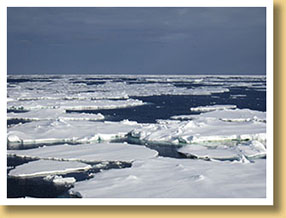 January 31, 2013
January 31, 2013
"We are about 1 1/2 days from an ice field, in the Ross Sea. The sky started out gray with no wind, and changed to jet blue and windy, but the surf was very mild. The Captain has been amazed by the weather. It was roughly 46 degrees outside, though the wind chill factor did take the feeling down to roughly 40. Still, it was warmer than at home three weeks ago! So far, still no whales. However, our lecture this morning was on the identification of whales as well as their behavior and the challenges they face, mainly from the Japanese. They are recovering from being slaughtered but some species very slowly. So far, the ten of us who saw the Orcas have been the only ones to see whales on the ship. We are told that once we break through the ice field that are slowly approaching, we will get the best chance to see them.
Today was open bridge day, so we were able to go spend time with the Captain and hear a lecture on how he drives the ship. He compared the equipment to a BMW with lots of automatic features. Very clear screens showing our route, destination and anything around us. Actually, there is absolutely nothing around us. Our ice briefing last night showed a wall of ice field across the opening into the deep Ross Sea, but with a clear path through it. We are not an ice breaker, but rather an ice pusher, which means we need ice less than 50% in density that we can shove around. 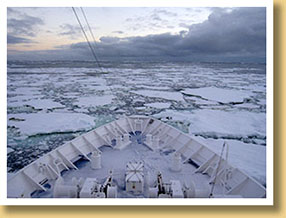 There is a clear gate in front of us, that will give us access to a huge clear patch of water almost 500 miles square that will allow us to get down to the Shackleton huts and the deepest possible penetration toward the South pole you can make by sea. The decision has been made to go straight there as it is such a clear shot. From there, we will make other landing as we head back north."
There is a clear gate in front of us, that will give us access to a huge clear patch of water almost 500 miles square that will allow us to get down to the Shackleton huts and the deepest possible penetration toward the South pole you can make by sea. The decision has been made to go straight there as it is such a clear shot. From there, we will make other landing as we head back north."
February 2, 2013
"As I write this, our ship, which normally has been traveling at about 12 knots is traveling at about 1 to 2 knots. We are traveling back and forth over the international dateline which is longitude 180 degrees, or directly opposite the longitude that runs through Greenwich England which is zero. As the morning progressed, we moved first into a field of small pieces of floating ice with the odd iceberg around. Over time, there was more and more ice to the point that there was no way through except to hit the smaller pieces. Our ship, which is normally quite stable is rocking back and forth since the Captain had to turn off and pull in our stability wings. 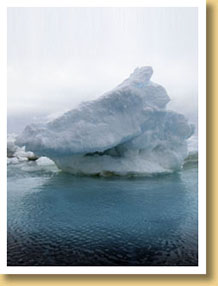 It is amazing how quickly you adapt to being able to walk around without having to hold on to the bannisters despite the ship rocking back and forth, up and down. As we move through the ice, there are repeated BOOM ... BOOMs as the bow hits a large chuck of ice and pushes it aside. Off on the sides of us are small icebergs, some of which are remarkable in that they are a very very deep blue. I have never seen quite this color. As the ship moves deeper into the ice field, the icebergs get larger and larger. My best way to describe this scene is that we are moving through a garden of white abstract sculptures, with an occasional deep blue gem. Some of the larger ones are perfectly rectangular, others look like castles. There was a perfect example of a chateau with soaring towers like those on the Loire River in France. Others are quite surreal. The full picture is simultaneously stark and stunningly beautiful.
It is amazing how quickly you adapt to being able to walk around without having to hold on to the bannisters despite the ship rocking back and forth, up and down. As we move through the ice, there are repeated BOOM ... BOOMs as the bow hits a large chuck of ice and pushes it aside. Off on the sides of us are small icebergs, some of which are remarkable in that they are a very very deep blue. I have never seen quite this color. As the ship moves deeper into the ice field, the icebergs get larger and larger. My best way to describe this scene is that we are moving through a garden of white abstract sculptures, with an occasional deep blue gem. Some of the larger ones are perfectly rectangular, others look like castles. There was a perfect example of a chateau with soaring towers like those on the Loire River in France. Others are quite surreal. The full picture is simultaneously stark and stunningly beautiful.
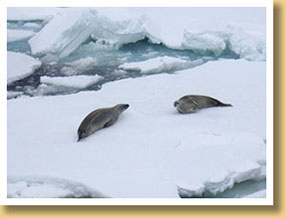 On some the larger pieces of ice, we occasionally see seals lounging around ... as many as five on one piece. The funniest was a single crab eating seal laying on a large block that was just off our bow. The animal looked sleek, silky and sleepy. Imagine, you are having a nice snooze and all of a sudden, here comesthis huge creature (our ship) and you are suddenly sharing your space with 90 people right above you clicking away with cameras. The seal woke up, look around, yawned, and went back to sleep. We decided that the whole ship should whisper so we didn't disturb him or her too much.
On some the larger pieces of ice, we occasionally see seals lounging around ... as many as five on one piece. The funniest was a single crab eating seal laying on a large block that was just off our bow. The animal looked sleek, silky and sleepy. Imagine, you are having a nice snooze and all of a sudden, here comesthis huge creature (our ship) and you are suddenly sharing your space with 90 people right above you clicking away with cameras. The seal woke up, look around, yawned, and went back to sleep. We decided that the whole ship should whisper so we didn't disturb him or her too much.
The temperature was roughly 27 this morning, but the wind chill factor took that below 20 degrees. It was quite chilling to any piece of exposed skin. The water is at 32.5, just over freezing. We have to get through this icy area to move into the southern Ross Sea. They tell us we are quite lucky in that we are not in fog or snow, but rather have overcast skies but eight or nine miles of visibility."
February 3, 2013
"We have hit 240 miles of ice ... normally they hit about 100 miles. So, it has taken a long time to get through it. Last night, there were very real questions about whether we would get through in time to have a chance to get down to the Antarctic ice shelf and Shackleton's huts. 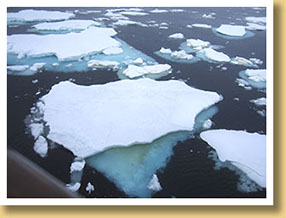 I stayed up on Deck Six to watch our progress. They said that we needed to get through by 6 am or they would have to cancel the trip farther south. As we went through the ice, starting at about 10:00 pm, we began passing a large number of really large icebergs. The ice intensified. Pretty soon we found ourselves watching the most wildlife we have seen in the ocean. As many as 10 to 12 Adelie penguins in a group. Generally, at least one was standing, with most scrunched down for the night. The sun sets about 11:00 pm and it rises somewhere around 3:30am, however, twilight persists the rest of the time."
I stayed up on Deck Six to watch our progress. They said that we needed to get through by 6 am or they would have to cancel the trip farther south. As we went through the ice, starting at about 10:00 pm, we began passing a large number of really large icebergs. The ice intensified. Pretty soon we found ourselves watching the most wildlife we have seen in the ocean. As many as 10 to 12 Adelie penguins in a group. Generally, at least one was standing, with most scrunched down for the night. The sun sets about 11:00 pm and it rises somewhere around 3:30am, however, twilight persists the rest of the time."